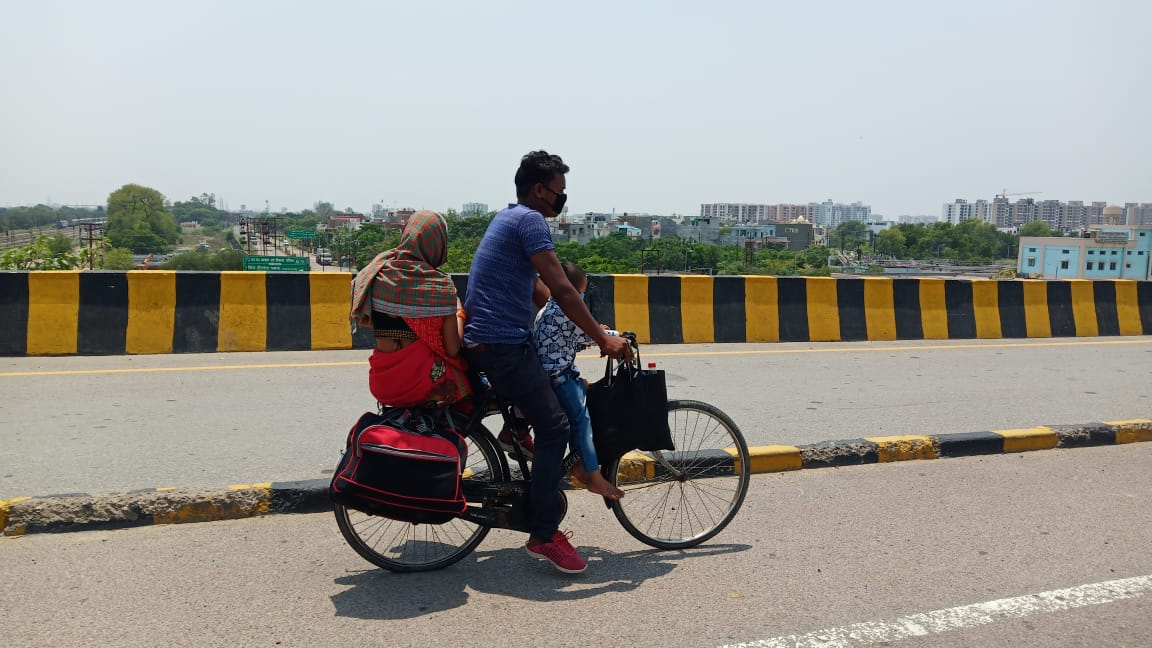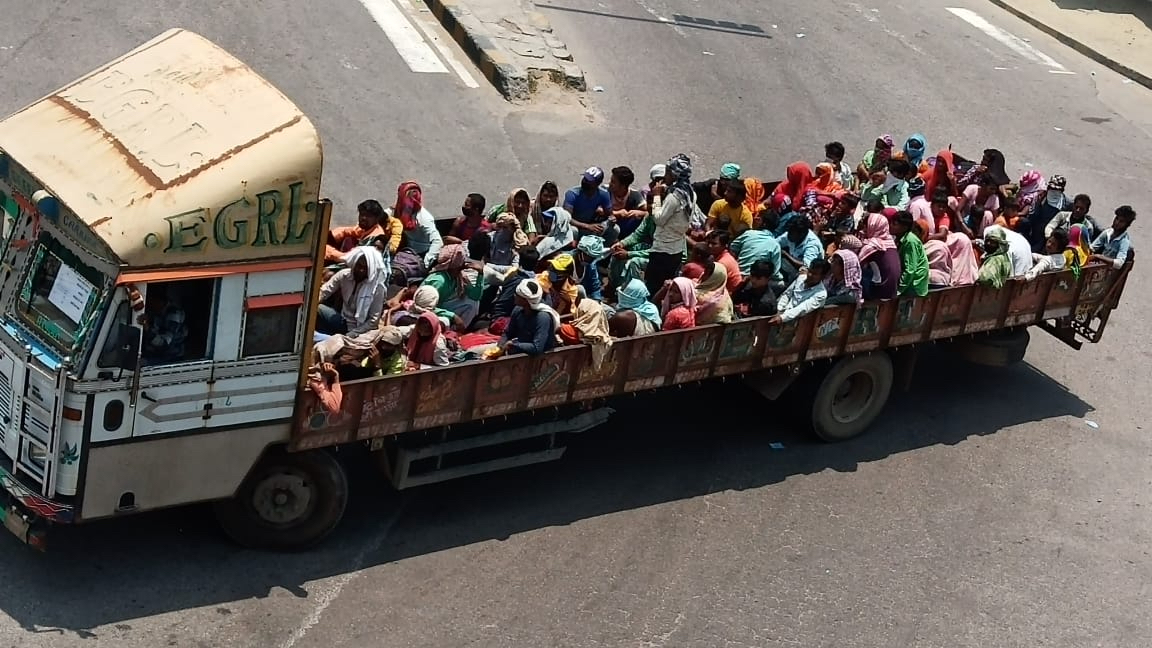
© ABP News Network, Pvt. Ltd., NOIDA, India
FOR GENERATIONS, IN INDIA AND AROUND THE WORLD, school teachers in classrooms have struggled to contain the impulse that children have to move around. Hundreds of psychologists, on the hunt for explanations for the comparatively poor performance of boys in schools, and their apparently increasing disdain for formal education, allege that children, and boys in particular, are naturally restless and that bookish learning and confinement to the classroom does them injustice if it is not a form of tyranny.
Whatever the merit of such observations, what is indisputably true is that school children have had this mantra drilled into them: “Be Still and Do Not Move.” It is the same mantra that the Government of India pronounced as virtually the law of the land when it imposed a countrywide “lockdown” more than two months ago with the stated intent of containing the spread of Covid-19. Six years into the rule of the Narendra Modi-led BJP government, nearly everyone in India has in all likelihood become accustomed to their infantilization by a state which acts on whim and expects complete adherence to the idea that a state which governs autocratically governs best. Some people might retort that India was scarcely alone in imposing a “lockdown,” but nearly every commentator who has been watching developments globally would agree that few countries, if any, imposed as severe and punishing a lockdown as did India. It is not only the case that India is almost exceptional in having a lockdown which encompasses the entire country, and that has now extended over two months: its singularity resides more particularly in the fact that it was imposed with four hours of notice to the country.
The script for “rule by fiat” was written in November 2016 when, in a similarly draconian move, Prime Minister Modi introduced “demonetization” one fine evening and the state decreed that all high denomination banknotes—Rupees 500 and 1000—would at once cease to be legal tender, though they could be deposited at a bank within a stipulated period of some weeks and be exchanged for new banknotes which were, not surprisingly, in very short supply. This supposed masterstroke, initiated with the intent of curtailing the “black” or shadow economy and stopping the cash flow to terrorists and corrupt businessmen, proved to be an utter fiasco. The Reserve Bank of India, the country’s central bank, reported in 2018 that 99.3% of the demonetized banknotes were deposited with the banking system; more importantly, its economic and social toll, especially on the hundreds of millions in India who eke out an existence from one miserable day to another and operate solely within a cash economy, was incalculable. It has been reliably reported that at least a few people died from heat exhaustion while queued up at an ATM machine for several hours.
The Prime Minister, we might say, likes to surprise his countrymen and women. But the surprise seems to have been sprung upon him, and his advisors—evidently none of whom likes to take stock of history, except only the history which purports to show the gloriousness of the Hindu past—since no one in his cabinet appears to have anticipated that hundreds of millions of Indians would not be prepared to follow the mantra he had decreed: “Be still and do not move.” The coronavirus pandemic has the world around generated images that will forever be etched in the memory of the living: great cities hollowed out; a nurse catching a wink of sleep in an ICU unit after nights of sleeplessness; the astonishing revival of bodies of water—ponds, lakes, rivers—no longer contaminated by man’s waste; and skies reclaimed by avian creatures.

© ABP News Network, Pvt. Ltd., NOIDA, India
It is doubtful, however, that a more moving, and some would rather say distressing, image of the pandemic has been generated than of large swathes of the country’s population taking to the road in the immediate wake of Modi’s pronouncement of the first phase of the lockdown on March 25. The country was at once shuttered, but in India this means much more than it does in most other parts of the world. All the metropolises, and often even smaller towns, are serviced by men and women who have fled the village for what they imagine will be a better life in the city. The maids and housekeepers—altogether unabashedly still called “servants”—may sometimes be housed in “servants’ quarters” in the somewhat more plush residential homes and apartments, but the greater number are daily wage earners whose working day often extends from 7 AM to 8 PM, and whose own children are either looked after by older siblings, other family members, or simply left to fend for themselves. The same holds true for drivers, guards, cooks, peons, delivery boys, construction workers, and practitioners of the various trades. Factory workers and construction laborers often sleep at the work site: when the factories were shut down on account of the lockdown, it also immediately left millions of them without a roof over their head.
India’s migrant labor work force is estimated at around 400 million. The “lockdown” left them without any means of livelihood, and the preponderant number of them without shelter; and so they did what Indians have done time after time: flee the city and return to the village. Mohandas Gandhi, who had the pulse of the nation, though many felt otherwise as he aged and began to be seen as an obstacle to India’s advancement as a “modern” nation-state, often stated that India lived in its half a million villages. He was ridiculed for his supposed adulation of the poverty-stricken den of superstition and backwardness called the “village,” but what Gandhi meant has been illustrated amply by the millions of Indians who have over the last two months taken to their feet and sought a return passage to their village. As the great ecological activist, Sunderlal Bahuguna, told me on a (still memorable) visit that I paid him at his ashram in the Garhwal hills some 35 years ago, Bharat ki atman gaon mein hain (“India’s soul is in its villages”). The village is where home is; it ministers to the soul. I am well aware that some writers and commentators in India will be inclined to dismiss such an observation as pure poppycock, cognizant as they are of the fact, to take one instance, that it nearly impossible to escape one’s caste in the village. To be sure, the city offers anonymity, a possible escape from caste, the strangulation of tradition, and history. But migrants have displayed a tendency to ruralize the city, if only because they must replicate the patterns of community to survive at all in a setting that still remains fundamentally alien to them.
What is unimpeachably the case, whatever one’s verdict on the Indian village, is simply this: India, indeed the entire world, has been witness over the last two months to hundreds of stories of the great migration back to the hinterland. The migrant workers massed first at bus depots and train stations, but the Indian state had suspended all transportation services. Some were able to hitch rides back to the village on trucks and other ramshackle vehicles which dot the country’s roads. But, for most, there was no recourse but to walk, and walk they did—some 50 kilometres, many others 500 kilometres, sometimes 50 kilometres a day, often without any food along the way. Some passed out on the road, quite a few have been run over by trucks: nothing glamorous here, nothing akin to Nancy Sinatra’s eros-filled, “These boots are made for walking, / And that’s just what they’ll do / One of these days these boots are gonna walk all over you.” India’s migrants are too wretched to have boots, some barely have any footwear: but there is no doubting that they have been “walked over.” There are other details, many that ought to put the country and its leaders to eternal shame, among them workers being sprayed like so many insects to disinfect them. The Indian’s proverbial inventiveness, captured by the idea of jugaad, will constantly find new registers of pollution and contamination in a country that is hideously caste-ridden.
Those observers with an eye for history thought they detected in the migrant trail the ghosts of the partition of India in 1947. That may be so, but myriad texts, one oral history after another, and countless folk memories point to something else: there is in India a long history of a people signaling its unhappiness with onerous taxation, unjust state policies, or the tyranny of a ruler, as much as its fear of the plague, pestilence, or an uncommon disease, by migrating en masse. In Mughal India, as many historians have remarked, people construed migration most often as a precondition for survival. The history of plague and pestilence in India is, moreover, inextricably intertwined with migration. In 1896, the first wave of bubonic plague struck India and lingered on for something like ten years, exacting a toll corresponding to the number of years. Bombay was seriously afflicted in September, and by January 1897 nearly half of Bombay’s population had fled to the countryside. Or consider this: Surat was struck by pneumonic plague in 1994, and the New York Times correspondent stationed in India, John F. Burns, headlined one of his stories on the plague thus: “Thousands Flee Indian City in Deadly Plague Outbreak” (24 September 1994). The article in its opening line went on to describe how 200,000 people had fled the city of Surat “after an outbreak of pneumonic plague that medical experts described as one of the most serious reported in the world in recent decades.” Writing some years later, the historian Frank Snowden in his book, Epidemics and Society, referred to the “almost biblical exodus of hundreds of thousands of people from the industrial city of Surat.”
The Indian state anticipated none of this; or, if it did, we can only surmise that the suffering of a large number of the country’s population is part of the mandate that Indians must accept as inevitable. What has transpired in India is one of the consequences of having entrusted governance, and that too through the ballot box, to politicians who are fundamentally unlettered, who treat the citizens of the country as a colonial state would, and who cherish the fantasy that they have helped in reviving India’s image abroad. But, in the migration of the present moment, there is also the enactment of national history. Almost nothing has altered the social landscape as much in the aftermath of independence as the immense drift to the city from the countryside, a staple theme of the commercial Hindi film until at least the 1990s. Who can really say what the post-pandemic future will look like? But what the pandemic may have wrought in India is a reverse migration that, one hopes, might even play a role in the reversal of the fortunes of the depleted and degraded hinterland. In the return of the migrants to their village, there may yet be the possibility of ministering to their souls—and the soul of the nation.
The author would like to thank Avinash Pandey, CEO of ABP, and Tushar Banerjee for making available the photographs taken by ABP reporters on the ground.
